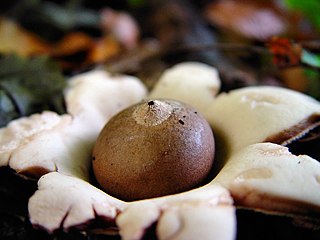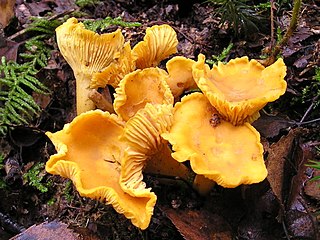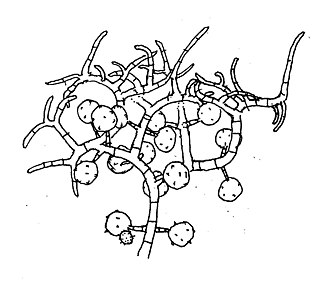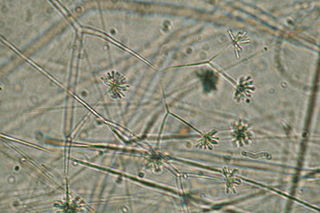
Geastrales is an order of gasterocarpic basidiomycetes (fungi) that are related to Cantharellales. The order contains the single family Geastraceae, which includes the "earthstars" formerly placed in Lycoperdales, or Phallales.

The Russulales are an order of the Agaricomycetes,. According to the Dictionary of the Fungi, the order consists of 12 families, 80 genera, and 1767 species. According to Species Fungorum, the order contains 13 families, 117 genera, and 3,060 species.
Order is one of the eight major hierarchical taxonomic ranks in Linnaean taxonomy. It is classified between family and class. In biological classification, the order is a taxonomic rank used in the classification of organisms and recognized by the nomenclature codes. An immediately higher rank, superorder, is sometimes added directly above order, with suborder directly beneath order. An order can also be defined as a group of related families.

The Cantharellales are an order of fungi in the class Agaricomycetes. The order includes not only the chanterelles (Cantharellaceae), but also some of the tooth fungi (Hydnaceae), clavarioid fungi, and corticioid fungi (Botryobasidiaceae). Species within the order are variously ectomycorrhizal, saprotrophic, associated with orchids, or facultative plant pathogens. Those of economic importance include edible and commercially collected Cantharellus, Craterellus, and Hydnum species as well as crop pathogens in the genera Ceratobasidium and Thanatephorus/Rhizoctonia.

The Agaricales are an order of fungi in the division Basidiomycota. As originally conceived, the order contained all the agarics, but subsequent research has shown that not all agarics are closely related and some belong in other orders, such as the Russulales and Boletales. Conversely, DNA research has also shown that many non-agarics, including some of the clavarioid fungi and gasteroid fungi belong within the Agaricales. The order has 46 extant families, more than 400 genera, and over 25,000 described species, along with six extinct genera known only from the fossil record. Species in the Agaricales range from the familiar Agaricus bisporus and the deadly Amanita virosa to the coral-like Clavaria zollingeri and bracket-like Fistulina hepatica.

The Phallales is an order of fungi in the subclass Phallomycetidae. The order contains two families: the Claustulaceae, and the Phallaceae, which, according to a 2008 estimate, collectively contain 26 genera and 88 species.

The Eurotiales are an order of sac fungi, also known as the green and blue molds. It was circumscribed in 1980.

The Hygrophoraceae are a family of fungi in the order Agaricales. Originally conceived as containing white-spored, thick-gilled agarics, including Hygrophorus and Hygrocybe species, DNA evidence has extended the limits of the family, so it now contains not only agarics, but also basidiolichens and corticioid fungi. Species are thus diverse and are variously ectomycorrhizal, lichenized, associated with mosses, or saprotrophic. The family contains 34 genera and over 1000 species. None is of any great economic importance, though fruit bodies of some Hygrocybe and Hygrophorus species are considered edible and may be collected for sale in local markets.

The Agaricomycetes are a class of fungi in the division Basidiomycota. The taxon is roughly identical to that defined for the Homobasidiomycetes by Hibbett & Thorn, with the inclusion of Auriculariales and Sebacinales. It includes not only mushroom-forming fungi, but also most species placed in the deprecated taxa Gasteromycetes and Homobasidiomycetes. Within the subdivision Agaricomycotina, which already excludes the smut and rust fungi, the Agaricomycetes can be further defined by the exclusion of the classes Tremellomycetes and Dacrymycetes, which are generally considered to be jelly fungi. However, a few former "jelly fungi", such as Auricularia, are classified in the Agaricomycetes. According to a 2008 estimate, Agaricomycetes include 17 orders, 100 families, 1147 genera, and about 21000 species. Modern molecular phylogenetic analyses have been since used to help define several new orders in the Agaricomycetes: Amylocorticiales, Jaapiales, Stereopsidales, and Lepidostromatales.

Blastocladiomycota is one of the currently recognized phyla within the kingdom Fungi. Blastocladiomycota was originally the order Blastocladiales within the phylum Chytridiomycota until molecular and zoospore ultrastructural characters were used to demonstrate it was not monophyletic with Chytridiomycota. The order was first erected by Petersen for a single genus, Blastocladia, which was originally considered a member of the oomycetes. Accordingly, members of Blastocladiomycota are often referred to colloquially as "chytrids." However, some feel "chytrid" should refer only to members of Chytridiomycota. Thus, members of Blastocladiomyota are commonly called "blastoclads" by mycologists. Alternatively, members of Blastocladiomycota, Chytridiomycota, and Neocallimastigomycota lumped together as the zoosporic true fungi. Blastocladiomycota contains 5 families and approximately 12 genera. This early diverging branch of kingdom Fungi is the first to exhibit alternation of generations. As well, two (once) popular model organisms—Allomyces macrogynus and Blastocladiella emersonii—belong to this phylum.

In biology, taxonomic rank is the relative level of a group of organisms in an ancestral or hereditary hierarchy. A common system of biological classification (taxonomy) consists of species, genus, family, order, class, phylum, kingdom, and domain. While older approaches to taxonomic classification were phenomenological, forming groups on the basis of similarities in appearance, organic structure and behaviour, methods based on genetic analysis have opened the road to cladistics.

The Taphrinomycetes are a class of ascomycete fungi belonging to the subdivision Taphrinomycotina. It includes the single order Taphrinales, which includes 2 families, 8 genera and 140 species.

The Zoopagomycotina are a subdivision of the fungal division Zygomycota sensu lato. It contains 5 families and 20 genera. Relationships among and within subphyla of Zygomycota are poorly understood, and their monophyly remains in question, so they are sometimes referred to by the informal name zygomycetes.
Dimargaritales is a monotypic order of fungi in the monotypic Dimargaritomycetes class within the subdivision of Kickxellomycotina.

Pucciniomycetes is a diverse class of fungi in the subphylum Pucciniomycotina of phylum Basidiomycota. The class contains 5 orders, 21 families, 190 genera, and approximately 8,016 species. It has been estimated that this class contains about one third of all teleomorphic basidiomycetes. Pucciniomycetes contains many economically important plant pathogenic fungal rusts; the order Pucciniales is the largest clade in this class, representing approximately 7,000 species.
The Zoopagaceae are a family of fungi in the Zoopagales order. The family contain contains 6 genera, and 78 species. The family was circumscribed in 1938.

The Sigmoideomycetaceae are a family of fungi in the Zoopagales order. The family contain contains three genera, and 4 species. The family was circumscribed in 1992.

The Piptocephalidaceae are a family of fungi in the Zoopagales order. The family contain contains 3 genera, and 70 species.
The Microthyriales are an order of sac fungi. According to a 2008 estimate, the order contains 3 families, 62 genera and 323 species. Species in the Microthyriales have small, flattened fruit bodies with one of more central slits, and are saprobic or epiphytic on the leaves and stems of plants.
Stylopage is a polytypic genus of predacious fungus in the order Zoopagales, within the subphylum Zoopagomycotina. All known species of Stylopage subsist on various species of amoebae or nematodes by trapping their prey, typically using an adhesive substance that coats their vegetative hyphae, and absorbing nutrients through the projection of a haustorium. 17 extant Stylopage species have been described thus far.














